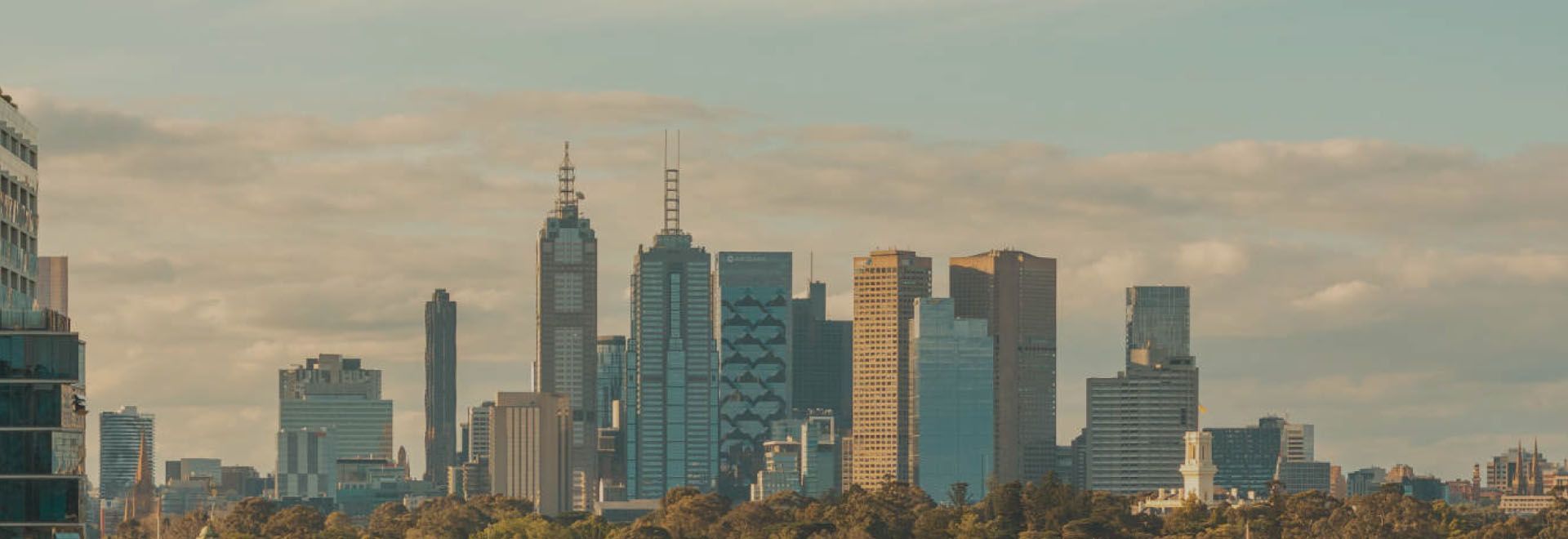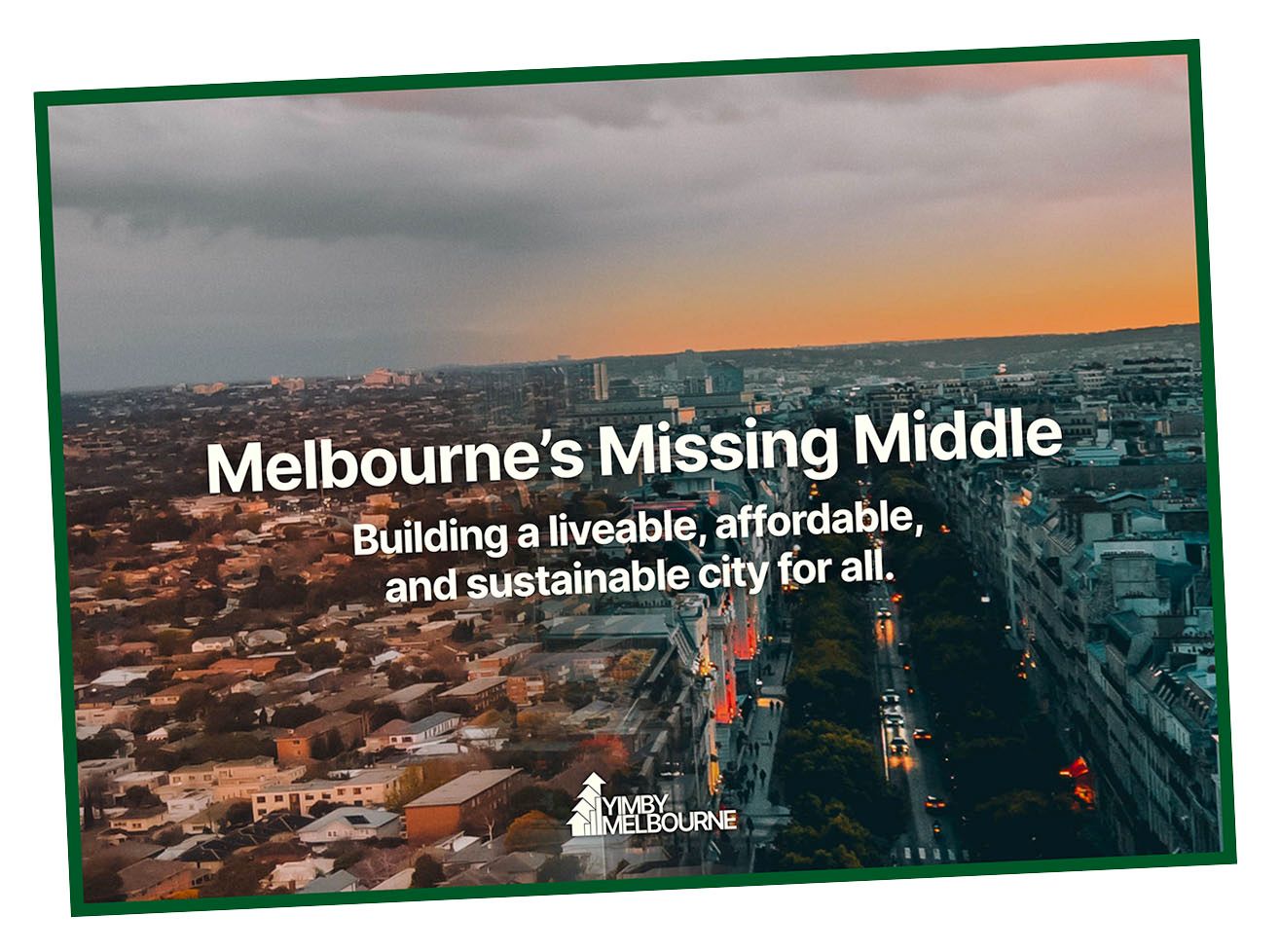Melbourne’s Missing Middle.
In the latter part of 2023, YIMBY Melbourne released a flagship report, Melbourne’s Missing Middle, on necessary changes to Victoria’s planning and tax systems to build a more liveable, sustainable and affordable city for all. Lead Organiser, Jonathan O’Brien, contextualises it for us.
For far too long, local council meetings have been dominated by a vocal minority standing against any change. These community members—termed ‘NIMBYs’ (Not In My Backyard)—have dominated housing consultation processes, exploiting planning systems and regulation to stop homes being built in their areas.

“Community opposition is actually stronger when the project includes significant portions of social and affordable housing.”
The romantic version of this story is the local community standing against an exploitative, profiteering developer—but, just as often, the case is the opposite. Community opposition is actually stronger when the project includes significant portions of social and affordable housing. This means that what often ends up happening in these meetings is that a small number of well-off locals and councillors fight against social and affordable housing, sometimes with an explicitly anti-social housing agenda, and sometimes for no clear reason at all.
The YIMBY (Yes, In My Backyard) movement emerged in response to this exact phenomenon. Beginning in California and spreading now across the world, the movement seeks to represent the largest and most systematically silenced stakeholder in any housing project: the people who would live in the homes were they allowed to be built. Over the past couple years, this movement has spread to Australia, including to my own city of Melbourne, where I run the local YIMBY organisation.
“This will sound obvious to those working in the social and affordable housing space, but it is true and worth saying: it is difficult to build homes.”
This will sound obvious to those working in the social and affordable housing space, but it is true and worth saying: it is difficult to build homes. It is difficult to get financing, it is difficult to procure correctly zoned land, it is difficult to get labour and materials, and it is difficult to get even the most compliant projects over the line with local councils.
This is not just an Australian problem, either—across the anglosphere, construction per-capita has slowed, and we’re building on the ever-bursting urban fringes with taxpayers and the environment picking up the bill for the damage that's wrought.
“A home is not just a roof over one's head; a home is also a location.”

And while sprawl may lead to marginally lower wellbeing for people in market-rate housing, it is a downright unviable situation for a good portion of social housing. Where tenants need support, or wraparound services, or reliable access to specific specialists or communities, the inner areas of our city are key. A home, after all, is not just a roof over one's head; a home is also a location. We need to build more social and affordable homes, and we need to build them in high-amenity, well-serviced areas.
The problem is, under current planning rules, this is broadly not allowed to happen. Which leads to the core issue the YIMBY movement seeks to confront: That zoning laws, as administered by state and local governments, have systematically locked people out of the inner-city by preventing anything new from being built.
Australian cities are not very dense, especially by international standards. The reality is that we could fit many more people in our inner-middle suburbs without even approaching the density of world-class cities like Paris.
Paris, as YIMBY Melbourne measured in our flagship report, Melbourne's Missing Middle, has a core area 40 times the density of Melbourne. And Paris is a great city—as are cities like Tokyo and New York. And yet Australian cities seem content to force people to live further and further out, rather than allowing the moderate change and gentle density that would enable more people to live in our highest-amenity areas.
“This is a political choice, and it’s one we can no longer afford to make."
This is a political choice, and it’s one we can no longer afford to make. It is time to allow more density in our inner cities—and not for the sake of property developers, but rather for the sake of social and affordable housing providers.
Making it easier to build has enormously positive outcomes. Recent zoning reforms in Auckland, Aotearoa New Zealand, were hugely championed by the region's leading social housing builder and provider, the state-run Kāinga Ora. And no wonder—after the city's reforms passed, state-developed dwelling completions increased threefold as a portion of total completions, which goes a long way to explain why the public builder was one of the most vocal advocates for upzoning in the first place.
Making it easier to build more homes helps everyone—especially those in the sector that provides housing for those most in need, on tight budgets, and with little capacity to deal with the ambiguity of an adversarial system of planning and zoning. The YIMBY movement is here to champion projects that enable people to live where they want and need to live—to create housing abundance accessible not only by rich landowners in Kew but by every single Melburnian, current and future.
A case in point: Housing wins the war in Wellington, NZ
In the stroke of a pen (and a six-hour meeting with many tedious amendment votes), Wellington moved from the most restrictive housing market in New Zealand to the most permissive… Read the full article in The Spin.
Listen to a special edition of podcast When The Facts Change, 'A battle won in the war for Wellington', where Bernard Hickey talks with The Spinoff’s Wellington Editor, Joel MacManus, about the historic victory for YIMBYs in the District Plan votes by the Wellington City Council in March 2024. Who knew that town planning could be so important?
https://open.spotify.com/episode/0kaXaLJPHtxbsladfqo56S?si=nXvaeVGiSbi7rJEiwK92kw
Podcast Transcript
In March 2024, some of the most revolutionary changes to Wellington’s planning regulations in more than 100 years were overhauled in a bid to tackle housing affordability and spiralling rental costs in Aotearoa’s capital city.
But that’s only part of the story here.
Burying the lede, as the saying goes in journalism, was a series of extraordinary decisions seemingly favouring proponents of the status quo handed down by the Independent Hearing Panel during the Wellington City Council’s 2024 District Plan review process. Cue what was then coined “The War for Wellington” by New Zealand news and pop culture website, The Spinoff.
In a special edition of his podcast series, When The Facts Change, New Zealand journalist Bernard Hickey talks with The Spinoff’s Wellington editor Joel MacManus about the historic victory for YIMBYs in March 2024’s District Plan votes by the Wellington City Council.
Bernard Hickey (BH):
“Something big has just happened in Wellington to give it a future. Wellington has struggled for over a decade now to actually consent to any new houses and get them built, particularly for people who are renting. It means now that it's the most expensive place in the country relative to incomes, to rent and to buy for people who are potentially not rich and don't have parents able to give them a big deposit or support them with their rent. It has stunted the growth, for example, of the University and of many of the businesses in and around Wellington and, of course, all of those government departments. It's meant that the population of Wellington — of young, wealthy workers — has stagnated relative to Christchurch and Auckland who have been more able to consent more homes. This all culminated last week in a "War for Wellington", as Joel McManus, the editor for The Spinoff in Wellington describes it, where the district plan, usually one of the most boring things you'll ever hear about, became the crucible for a battle between YIMBYs — 'Yes, in My Backyard' people — and NIMBYs, ‘Not in My Backyard’ people, to try to ensure that there is enough housing for young people in Wellington in the years to come.”
“This is after an Independent Hearings Panel shocked everyone by downzoning the initial version of the District Plan and the Wellington City Council had to consider proposals to re-upzone Wellington's District Plan. This will now go before Chris Bishop for approval, but in this week's special When the Facts Change [podcast], I talked with Joel McManus about how this all came to pass, what it means for people in Wellington; how it's going to have an impact on the rest of the country, and what might happen next with Chris Bishop and the politics within the National Party. That's this week on When the Facts Change.”
“Kia ora, and welcome to a special edition of When the Facts Change with Joel McManus, who is The Spinoff's editor in Wellington. Lovely to have you on When the Facts Change, Joel.”
Joel McManus (JM):
“Kia ora Bernard, it's great to be here.”
BH: “I've been watching from afar here in Auckland, cheering you on and cheering on the YIMBYs of Wellington who have been taking on the NIMBYs for a couple of years now, and cutting to the chase of the news that's happened this week; tell us about the meeting of the Wellington City Council in Wellington yesterday, and why it was so important.”
JM: “Right. This was the end of a process, which has gone on for literally years to redefine the rule book for housing in Wellington. There's been a lot of back and forth, a lot of hearings, lawyers, activists, everyone from all sides is having this input about where apartments should be allowed, how tall they should be, where we can build townhouses."
"Right now, Wellington, at least previously, had an incredibly restrictive housing market. It was really difficult to build anything tall anywhere near the centre [of the] city. And yesterday's District Plan Meeting changed that immensely. Literally, Wellington has gone from the most restrictive to the most permissive housing market in the country. So, yesterday's meeting was six hours of amendments, not the sexiest stuff, but what we had was there was a draught district plan. Then, this Independent Hearing Panel came in, listened to about 300 hours of hearings from submitters, local residents about how the District Plan should be. They put out their recommendations. You and I have both covered them. They were quite controversial, reduced housing by a lot. So yesterday, councillors had the opportunity to introduce a number of amendments to overturn those recommendations, which they did, and signed off the final District Plan, which, as I said, is a massive change for this city.”
BH: “And just to give our listeners a sense of how much Wellington's housing supply has been restricted, and how it's affected prices of houses, but also rents and affected how, particularly, young renters have coped—or not coped—with living in Wellington, and the flow-on effects. Because of the restrictions on development, a lot of housing in and around the CBD – so Mount Victoria, Kelburn, Thorndon, Mount Cook, Newtown, Berhampore, Kilbirnie, those sorts of places – it's been impossible to build any sort of three- or four-storey apartments or townhouses. Essentially, it's locked in as a series of villages full of 1905 style villas, some of which have been turned into flats, some of which have been renovated to within an inch of their lives, and all of which are restricting the number of people who can live somewhere close to town. Unlike in, for example, Lower Hutt, where there has been an upzoning in recent years, unlike in Auckland where there has been an upzoning, Wellington has been restricted, and it's meant that the number of building consents per thousand people has been pretty much the lowest in the country in the last 10 years.”
“And what that's meant is that rents as a share of incomes have risen sharply. Also, house prices rose very sharply and then fell very sharply. But in essence, it's still pretty much impossible for anyone to buy a house or actually even an apartment off their own bat in Wellington. When I say off their own bat, [I mean] not without a big deposit from Mum or Dad or whoever. And what it's meant is, in my view, is that Wellington's growth as a city for jobs for education has been strangled. And you can see that in the enrollment stats for Victoria University. And you can also see it in the problems that the likes of Wētā Digital, a lot of the big government departments, a lot of the tech firms in Wellington have getting staff. And you can see that in the number of workers in Wellington and how fast it's grown compared to Auckland and Christchurch in particular."
"So, Joel, could you just go into a bit more detail about this Independent Hearings Panel, which is usually a fairly anonymous group of people, but in this case, they came out with a report that shocked everyone. Can you give us some examples of those little shocks things that when you look at them close do you think, how did they come up with that?"
JM: “There was a lot of stuff that was quite seriously either just kind of illogical and, in a lot of cases, just factually wrong. So, it kind of started from this basis that upzoning doesn't affect housing supply or affordability. They took that as their starting point because they had evidence from one pretty fringe economist, one of the few people in the world who take that position, and they used it to kind of define everything. So, every time a submitter asked for taller heights or more housing or smaller character areas, they said, well, there's no evidence that upzoning allowing more housing will actually affect housing affordability, so there's no point in doing it.”
BH: “But surely Housing and Urban Development and Kāinga Ora and Treasury and every other economist put in their papers with the academic research and the peer-reviewed papers showing that the upzonings in Auckland and in Christchurch after the earthquakes have had a huge impact. And not so much reducing rents or prices but reducing the growth of them, and actually improving some of the rental affordability in parts of Auckland to the point where these papers by Ryan Greenaway-McGrevy are now cited internationally as peer-reviewed research you can rely on to show that increasing housing supply improves housing affordability. I don't understand how the Independent Hearings Panel could ignore that…”
JM: “Well, Bernard, they were all presented to the Independent Hearing Panel, and the Independent Hearing Panel made a number of really strange decisions to discount evidence either dismissing entirely or down-weighting it. So, all of those studies you referred to about Auckland upzoning were presented by the Ministry of Housing Urban Development, by Generation Zero by quite a few groups because they're quite famous studies. In that particular case, the panel said they couldn't consider those studies as evidence because the researchers themselves were not presenting them, which is a crazy position for an expert panel to take to suggest that any empirical evidence can't be taken into account unless the actual researcher themselves is there!"
"But there was so many more examples of this. Almost everything the Ministry of Housing and Urban Development submitted was given very little weight because they said the person who submitted it was a senior financial analyst and not a lawyer or planner or someone who could comply to the code of experts. So almost all of that was dismissed. There was just mountains of stuff that was dismissed... when they were deciding the walking catchment — so everything within walking distance of the centre city needs to be upzoned, Waka Kotahi presented census data where they'd asked people how they got to work. And a lot of people in Newtown said they walked to work. The panel said they couldn't consider that because the census only asked how they got to work and didn't ask how they got home.”
BH: “What were they – Captain-Kirk-style 'beam me up, Scotty' getting home? Maybe that's how it worked?”
JM: “According to the panel chair Trevor Robinson, it was an evidentiary hole that they could not explain, and so they just dismissed it.”
BH: “So even for Independent Hearings Panel, this was off the charts because, for example, the IHP that looked at the Auckland unitary plan had been quite pro-upzoning. How was this panel appointed and how did we get such a bunch of downzoners?”
JM: “Well the panel was appointed by the [Wellington City] Council. I looked into this. That was a fairly normal process. They listed it on [GETS.gov.nz], the government's tendering service for contractors. They got eight applicants. They hired six of them. There were two more panellists that were hired in other ways. The council had to vote to approve them. They gave them a pretty strict list of what they had to do. So, the question of how they ended up in these positions, I mean, I really don't know. I dug into their recommendations a lot. I use the logic of ‘Hanlon's Razor’ – never apply malice to something which is equally explained by incompetence – and I looked through every recommendation they'd made. And even when they're strange, and you just have to assume, I guess, that this was a series of mistakes from people who should have known better. The most serious example in my view was the evidence that they used from Generation Zero.”
“So, in two separate reports, Generation Zero was completely misattributed. So, in one example, there was a line in the panel's report that said Generation Zero had provided no evidence or analysis to suggest that upzoning worked. That wasn't true. They'd presented all of those studies in Auckland. And, in their second report, there was a line saying that Generation Zero said that inner city land would always be expensive, so there was no point upzoning it, which is definitely not what Generation Zero said. They said the exact opposite; that because the land's expensive, you should upzone it because it will bring the price of housing down. I mean, both of those are just so egregious and fly in the face of just… facts. I really don't see any explanation there.”
BH: “So yesterday was a meeting in which the Council, on the face of it, is pretty evenly balanced between what you call progressive Green/Labour forces and Conservative forces. And there are some, well-known, established Conservative names in there. Diane Calvert, for example, who have been pretty much anti-upzoning, pro-heritage areas, anti-higher buildings anywhere near the centre of Wellington. And, on the face of it, this looked like it could have been a really tight battle, but as we went through the day, it became clear that the YIMBYs were winning hands down. What went on here?”
JM: “Yeah, you're right. It was almost shocking. Every amendment, there were 26 amendments total, 25 of them passed, and most of them passed easily. If you break down the numbers, we kind of knew going in there were four Labour, four Green, one of the Iwi representatives who'd basically committed to the pro-housing side. So that would've been a tie at worst. And Tory Whanau as the Mayor would've had the tie-breaking vote. But, a lot of the decisions were passed by a much larger margin. The character areas only had six votes against. The closest one was the Johnsonville rail line. That was a 10 [to] eight vote. But almost everything else sailed through.”
BH: “On that, just for those non-Wellingtonians and maybe car drivers who have heard about this Johnsonville rail lines debate and going, ‘what is it with this Johnsonville?’ Can you just explain what's going on here with the Johnsonville rail line; why it's so important that it's actually counted as mass transit versus a bunch of lines of steel?”
JM: “Yeah, yeah. This has been one of the strangest but also funniest debates of this whole process. So there's a rule in the NPSUD — the National Policy Statement on Urban Development — that says you must upzone to allow six-storey apartments within a walking distance of a mass rapid-transit station. And 'mass rapid-transit' is a term that basically means train. It can also mean subway, tram maybe, but that's what it means. And yet, a previous Council and the Independent Hearings Panel through spurious logic decided that the Johnsonville rail line was not a mass rapid transit. It was something else entirely. And that the impact of that, of course, is that by defining it as not mass rapid-transit, they didn't have to upzone around the stations. So, that was one of the big decisions at yesterday's meeting. The council redefined it as mass rapid-transit. They actually even expanded the walking distance from five minutes to 10 minutes along all those stations. So there's, I think, six stations on the Johnsonville rail line. There's also three on the Kapiti line that fall within Wellington boundaries, so they've all been expanded, they're all upzoned now. And when you can kind of combine a 10-minute walking distance across all of those places, that's a huge amount of land that's been upzoned.”
BH: “And remembering, for people who don’t know why the 10-minute versus five-minute is important, how much more dense can you get in that walkable catchment from a station than just regular old suburban?”
JM: “Well, I mean, so those walking catchments are allowed 22-metre height limits, so about six-storey apartments. Obviously, currently in most suburban areas in Wellington, you're talking one or two storeys. With the MDRS, there'll be three storeys, but now it's up to six. So that's a lot more housing.”
BH: “So this was a real backlash against the IHP and a wipeout, so to speak, in political terms, if you're looking at it in a horserace. But we've been here before. I got quite excited when National and Labour came together in a bi-partisan approach to introduce MDRS Medium Density Residential Standards, which allowed three-storey townhouses on a regular section without the need for resource consent. And eventually there was a backlash within the National Party in particular, but also ACT – a supposedly libertarian pro-property rights group that wanted to stop neighbours of ACT party supporters from building anything. But that meant that the bi-partisan deal was abandoned before the election. And Chris Bishop, who is quite unusual, I suppose you could call it within the National Party, in that he's quite urbanisation and pro-public transport, or a lot more than Simeon Brown for start it appears. It's not over until the fat lady signs on the line. So, is there a risk here that Chris Bishop who does have final say on ticking off this district plan, could he come back in with a bunch of ye oldie NIMBY support or opposition from within the National Party to say, right, let's downzone this upzone plan?”
JM: “It's a really interesting question. So, Chris Bishop's quite limited in his choices. He can't rewrite the plan. He just has to choose between the Council's new amendment or the one the Independent Hearing Panel put up. And, everywhere where they don't align, he has to pick one or the other. Now, Chris Bishop has definitely been signalling that he wanted more upzoning and more housing. He gave a few speeches throughout this process, very urbanist, very clearly sending that signal from some of the people who have been talking to him in the background and some of what I've been hearing, he's definitely sending the same signal through the back rooms. And it is notable in this case that it is just the Minister that signs off. It does not need to go through Cabinet. He doesn't need the support of his other parties. It's just him. So, there's really no reason why he shouldn't. But it's politics, right? Anything could happen. Whether that means some sort of backlash, particularly from the northern suburbs, which are more of a National Party based in Central Wellington is maybe, but at this point, I'd definitely be predicting that Bishop is going to approve some or all of these changes.”
BH: “So, let's assume that Chris Bishop ticks the version that's just gone through the Wellington City Council. Now that doesn't necessarily build any houses because one of the things we've learned over the years is that you can have the zoning, but if you don't have the pipes, and you don't have the roads, and the schools, and all of the other deeper infrastructure, you need to upzone and densify, you know, improve footpaths, improved public transport, that can really put a spanner in the works. So, what's the capacity for Wellington Council and the Wellington Regional Council who will be funding a lot of this water and public transport infrastructure to actually put meat on the bones of this upzone plan?”
JM: “Well, like you say, upzoning doesn't cause houses. You need someone to build them. So that's the next step, the next challenge, they need to get more developers on side. There's actually only a small number of developers really operating at scale in Wellington, but hopefully this plan will attract more to the city who are willing to build, build, build. Most of the inner suburbs, the places they have upzoned are actually fairly well suited for it, right? There's a reason that you upzone around walking catchments and train stations. That's where the capacity is. People can walk to work, people can walk to the train. The transport is less of an issue than if you are chucking a bunch of apartments way out in a suburb where everyone needs to drive."
"And the pipes, it's no secret that Wellington's pipes are a bit munted. But the one thing I guess you can say from this is by increasing density, you get more residents and more ratepayers. So, you can maybe start to spread the cost of that fix because there's really no other option. What we do see is the inner suburbs, the inner city, there is actually more water capacity than people might think. The inner city itself has huge pipes because they have to supply all the offices. So, there's actually this really large pipe capacity in the CBD that is mostly only used for the daytime because more people work there than live there. So, there is definitely is capacity, but it's not an easy fix.”
BH: “So it's been a heck of a few weeks and months covering Wellington. And you've launched a campaign, if you like, something ye olde newspapers used to do, campaigns for things, ‘The War for Wellington’. Can you tell us about what you've been doing there? And for those people who are interested, how they can sign up and get involved — or at least get all the material that you're putting out?”
JM: “So, The Spinoff is new to having full-time staff in Wellington really dedicating to coverage of this city. And this campaign was something I kicked off two months ago. It really was just, you know, we knew that this was a huge opportunity to change housing in Wellington. We'd seen what had happened in the Auckland Unitary Plan." The Spinoff ran a campaign in 2016 about that called ‘The War for Auckland’. And so, the initial goal was really just to get as many people to care and be invested in the district plan process, and understand why it was a huge deal for the city. It turned into something much, much bigger once these Independent Hearing Panel reports started coming out, because we never could have predicted that they would be so controversial and full of such absurd decisions. And so that kind of turned it into a story that was huge, and a lot of people were really engaged in and angry about.”
“So, from there, it's been this amazing story. We've had lots of… I've been covering the Council, we've had lots of contributors, activists, experts, economists, writing, giving their input. Stuart Donovan, who you've dealt with, did some amazing takedowns of the panel's economic evidence. And yeah, we took an editorial line that we believe density and more housing is a good thing for Wellington. That's in my view, not a particularly controversial opinion but it is still somewhat of an opinion. We didn't campaign for any specific outcomes apart from just more density, but we were very clear about that and we listed things as opinion when they were opinion. And the outcome that we saw yesterday is remarkable. I wrote this morning, I think it is the single biggest urbanist victory in the history of New Zealand. The biggest moment for the YIMBY movement. A lot of these decisions go well beyond the MDRS or the Auckland Unitary Plan. They've removed setback requirements. That's a very small technical point, but it's a big deal for getting more housing built.”
BH: “Yes, for those people who are in the business of designing floor plans and working out square meterage, being able to bring your apartment closer to the front of the property and not have to put an arbitrary laneway down the side gives you a lot more freedom to do interesting things, including increasing the size of your backyards and your common areas to make them much more livable. And it's really positive.”
BH: “Joel, it's been wonderful to chat. Thank you very much for all the work you've done with The War for Wellington, which no doubt will carry on. And this great battle of our age between the YIMBYs and the NIMBYs will carry on because it's never a one-way traffic. And it's one of these essential clashes between not just generations but views of the world and pots of wealth. And Wellington was the most blighted of our cities, and now it's put in place a set of rules which could help other parts of the country densify. And, as it turns out, looking around on the global YIMBY boards and Twitter handles and that sort of thing, this has gathered quite a bit of attention internationally as well. So, it will be an interesting one to watch. Joel McManus, the editor in Wellington for The Spinoff, thank you very much for being on When the Facts Change.”
JH: “Thanks Bernard.”
BH: When the Facts Change was brought to you by the Spinoff Podcast Network. If you enjoy listening to our podcasts, consider supporting our Mahi by signing up to become a Spinoff member.
Share This Article
Other articles you may like









